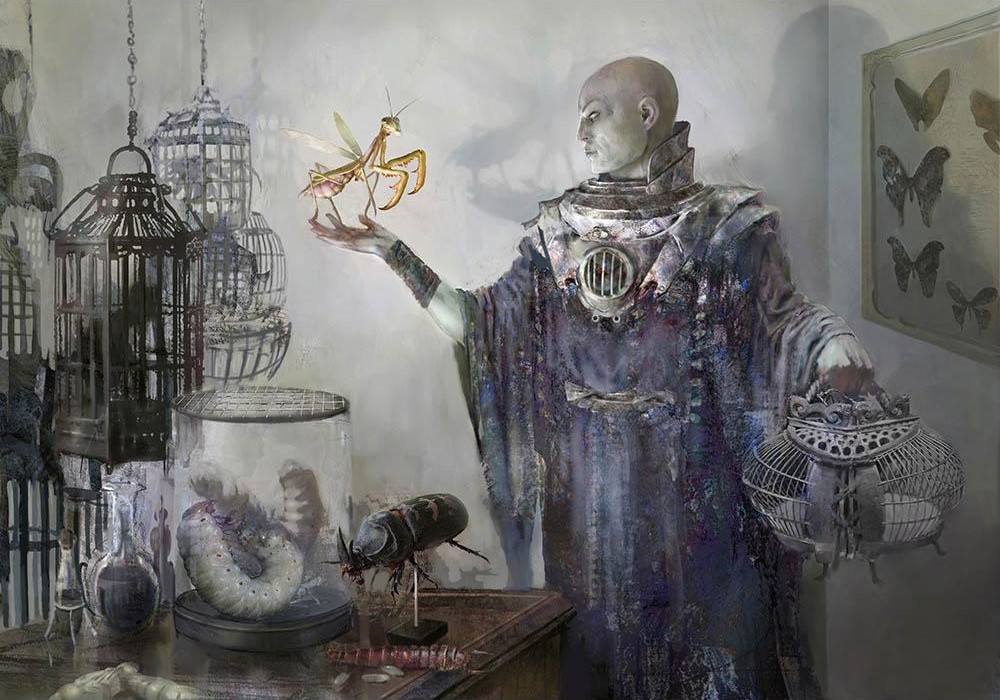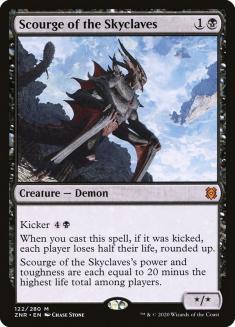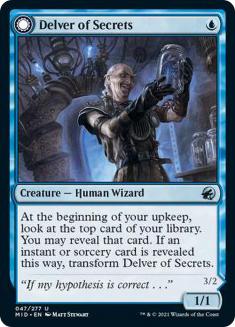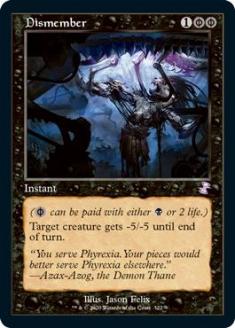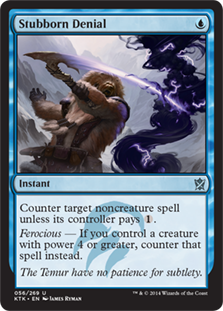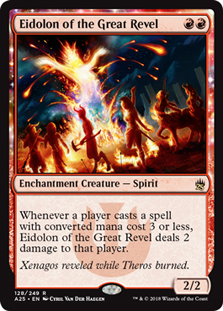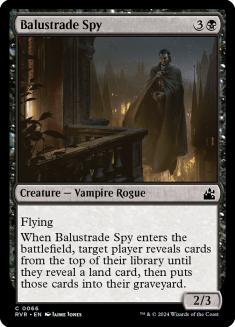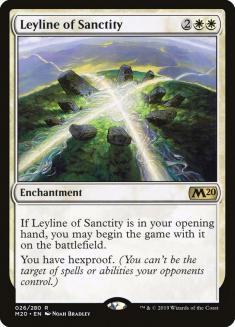So about the elephant in the room…
Modern has been shaken up quite a bit from Zendikar Rising, adding plenty of staples to the format in the form of DFCs, but Scourge of the Skyclaves has singlehandedly reinvigorated the Death’s Shadow archetype. Turns out that having eight of something instead of four ends up making your deck a bit better! Like Death’s Shadow before it, Scourge of the Skyclaves looks big and menacing but pretty difficult to turn on. In actuality, your opponent just deals themselves damage every now and then from their lands, which in turn makes Scourge of the Skyclaves more like a Tarmogoyf that eventually turns enormous.
One big takeaway here is that we don’t have to play green anymore. Tarmogoyf was that “extra Death’s Shadow” because it was just a large body that was more consistent but ultimately less powerful. Gurmag Angler, which was the de facto second body in Grixis or other black-based versions of Death’s Shadow, suffered from a reliance on the graveyard. It also never scaled as the game progressed, and was okay with Temur Battle Rage but not often game-ending. Gurmag Angler also forced you to play weak cards like Thought Scour that didn’t really fit into the archetype other than to enable Gurmag Angler.
Scourge of the Skyclaves is the current hot button in Modern because it’s new and it’s also been exceeding expectations. Ari wrote about Rakdos Death’s Shadow last week, focusing on how the deck interacts in a variety of matchups, including a sideboard guide. It was extremely helpful for learning how the deck operates, as well as your role against each of those top contenders.
The Rakdos Death’s Shadow (Lurrus) deck has gone through some changes since Ari put that piece together. A shift toward Bomat Courier gives the deck some card advantage, as well as a way to reset your bad hands full of discard in the later turns. It was much better than I anticipated, both playing with and against it. That made me question the one-drop suite entirely. Monastery Swiftspear and Soul-Scar Mage make a lot of sense, and especially so if you want to play cards like Lava Dart to help trigger prowess.
But what if Lava Dart is bad?
The original versions of Rakdos Death’s Shadow are powerful because you have a ton of discard and two versions of Death’s Shadow. That disruption coupled with the stopping power of those two big threats, as well as the efficiency of removal like Lightning Bolt and Fatal Push, makes the deck a serious contender in Modern. Temur Battle Rage has long been one of the most terrifying spells in the format.
It’s clear that eight threats isn’t enough. You want more than just Death’s Shadow and Scourge of the Skyclaves to help weather all of your opponent’s removal, as well as help pressure your opponent’s life total so your Scourge of the Skyclaves can come down more quickly. You can also pair Death’s Shadow and Scourge of the Skyclaves with a host of different disruptive and lock pieces, using them to increase the potency of cards like Liliana of the Veil or Stubborn Denial. Like builds of Death’s Shadow in the past, there’s a lot of room for customization as long as the core of the archetype is there.
Today we’re going to explore my favorite build featuring Scourge of the Skyclaves:
Creatures (12)
Lands (17)
Spells (31)

Strengths
This version features two things I really like: Delver of Secrets and a hefty amount of cheap removal. Delver of Secrets tends to be better when you’re more reactive. If you play it on the first turn, your opponent has to respect it or else it might ultimately steal the game. Even if it doesn’t win the game by itself outright, it usually does some amount of damage or absorbs a removal spell which in turn allows your bigger threats to go uncontested. Delver of Secrets is a first-turn play that doesn’t require finesse or thought. Playing it makes all your disruption better.
While your ideal first-turn play is a Delver of Secrets, it’s certainly fine on the second or third turn in conjunction with your other threats and disruption. Because we only have twelve creatures and a low land count, your Delver of Secrets transforms naturally more often than usual. When Delver of Secrets is a reliable threat, that’s nutty for your archetype because you get to start all your plans about two turns earlier than normal.
The abundance of cheap spot removal is a nod to the Scourge of the Skyclaves “mirrors.” Each of these decks needs to be attacked via brute force. Due to the overwhelming amount of discard, specific hate cards or answers aren’t reliable. You need to beat them by drawing more interaction than they have threats. Playing four copies of Fatal Push helps greatly in that regard.
Lightning Bolt is particularly useful in this deck, doubling as a removal spell as well as a way to turn on your big threats. Bolting yourself isn’t uncommon at all, which is usually fine because that means your life total isn’t under a lot of pressure from the opponent. Of course, if your opponent is aggressive, your life will naturally decrease and you can use Lightning Bolt defensively. Plus there’s that whole “killing them with they’re at three life” thing.
Dismember is seeing a resurgence because creatures are coming back. With the addition of Scourge of the Skyclaves, a lot of creature-based strategies are returning, which in turn makes removal better. Dismember is seeing more play because of that, but also as a way to use your life total for an advantage rather than no gain. That’s why you’re seeing fewer copies of Street Wraith. We don’t mind dealing ourselves damage as long as we get something for the exchange.
While this card gets sideboarded out a lot, it’s one of your insurance policies against weird combo decks while helping to protect your bigger threats from removal. Stubborn Denial doesn’t often do anything worthwhile without Ferocious, but the occasional snipe on a three- or four-mana planeswalker is pretty nice when all you have hanging around is a Delver of Secrets.
Remember earlier when I said Delver of Secrets helps make your disruption better? The truth is that any clock can make your disruption better, but Delver of Secrets being a one-mana threat that can stand alone without much help makes it an ideal starter for playing counterspells. Stubborn Denial doesn’t quite work with Delver of Secrets per se, but that pressure can force your opponent to run head-first into an underpowered Stubborn Denial, giving it more value than it would normally have.
This sideboard option is powerful but inconsistent. Drawing one in the later turns is a disaster, especially so now because we don’t have any copies of Faithless Looting to throw them away. However, there are so many decks in the format where Leyline of the Void is an actual dagger to the heart, giving you a huge leg up when you draw them. Because we need those hate cards within the first few turns to have a shot at winning, playing four copies of the highest impact one makes more sense than just playing a few Nihil Spellbombs. Since we’re more reactive than most Death’s Shadow decks, and only have two copies of Temur Battle Rage, we need our hate cards to be strong and plentiful.
I know that siding in Leyline of the Void invalidates Lurrus of the Dream-Den, but the matchups that require Leyline of the Void rarely need to play a longer game. Plus, the nerf on companions makes Lurrus more of an afterthought than a major part of the archetype. It’s obviously good in the later turns of the game, but it’s nowhere near as powerful as it was before.
Weaknesses
While you have a lot of spot removal, you’re relatively weak to more aggressive strategies featuring a lot of burn spells. Specifically, Eidolon of the Great Revel is problematic because we don’t have Gurmag Angler and can’t close the game as quickly as I would like. Stubborn Denial and such can steal games if you get on the battlefield quickly to get ahead, but more than likely having those reactive cards stuck in hand will be your downfall. Their entire plan focuses on doing one thing: getting you down to zero life points. Your plan is a bit more scattered, trying to cover bases while drumming up some pressure. Mostly, you just need time to strip the game down to its bare components to gain an advantage, and that’s much harder to do when the game is shortened by two or more turns.
Not that I’m advocating that the Oops, All Spells deck is good or even playable, but I’ve run into it a few times so far. It’s certainly a deck in the format and one that can be somewhat troublesome to interact with thanks to Leyline of Sanctity. Bricking your discard is a huge deal here, as they are your main form of interaction against combo decks.
They have eight cards that essentially say “I win” that you can’t really interact with once they’re on the battlefield. Stubborn Denial doesn’t do the job either because it only tags noncreature spells. If they start with Leyline of Sanctity, interacting at all seems pretty difficult! But that’s kinda the nature of the matchup, right? Their entire deal is trying to goldfish, as they don’t play a regular game of Magic. Normally, this archetype is quite powerful against combo decks, but that one in particular is potentially troublesome.
Delver of Secrets and Death’s Shadow in general are often weak in a format full of control decks. Those decks tend to overload your creatures with an abundance of removal spells, and you need to play very few creatures in order to make Delver of Secrets better. The same thing happened in Legacy when Death’s Shadow first became popularized at the hands of Josh Utter-Leyton. While I had a lot of success with that archetype in Legacy, Miracles was often problematic due to the high volume of removal and redundancy.
Uro decks featuring a ton of removal and card advantage can give you headaches if their spot removal of choice is Fatal Push. Lightning Bolt isn’t usually problematic, but cheap hard removal for your threats is occasionally too much for you to handle. You can obviously win games via Stubborn Denial, but just as many games end with you having one or two stuck in your hand after your opponent kills your threat. Uro is almost a natural foil to interaction since you can’t really kill it. It also thrives in formats where both players are low on resources and continually trying to strip each other of resources via discard.
Why Grixis Delver Over Rakdos?
Creatures (16)
Lands (17)
Spells (27)

This version is pretty close to stock, though a Bomat Courier version has been seeing a lot of play recently. Comparing these two archetypes is difficult because they do a lot of the same things. Both versions play discard, removal, and huge monsters, but if I’ve learned anything about Magic in my career, it’s that the devil is in the details.
Delver of Secrets essentially turns this archetype into a completely different deck. You want to play slightly longer games because you have the tools to play longer games. Your interaction is more surrounding, checking the opponent from multiple angles at once. You still have similar explosive draws to the Rakdos version, though the prowess threats give them a bit more consistency in that department. In a lot of ways, playing sixteen creatures makes your deck less consistent because you occasionally draw too many threats. I don’t know if you’ve had a game or two where you flooded out on creatures, but that definitely happens with Death’s Shadow all the time.
I’m glad we’ve moved away from Street Wraith in general, as having more life to work with means fewer dead games and dead draws as the life totals get tighter. It’s clearly not very hard to deal yourself damage, as we could just play Agadeem’s Awakening and are choosing not to. I’m a bit jealous of the Rakdos version getting to play Mutagenic Growth, but it’s such a high-variance card that I’d rather take the Delver route.
And that’s the biggest difference I’ve found in the archetypes: the Rakdos version feels a lot like Infect in that your deck feels like it has fewer dimensions to it. You’re all-in on the wonky stuff. When you play Apostle’s Blessing and Mutagenic Growth, you have draws that don’t really mesh together in the face of heavy disruption or a heavy clock. High-variance cards lead to lopsided games, but that doesn’t always mean you’re winning. In fact, if playing Mutagenic Growth in Mono-Red Prowess has taught me anything, it’s that Mutagenic Growth will always be worse than it looks on paper. Take it from me, the guy who’s played Mutagenic Growth in more deck in more formats than any other human.
If you want consistency, Grixis Delver Shadow (Lurrus) should be right up your alley. The Rakdos versions are more explosive, but they’re ultimately more vulnerable to disruption and removal. Because of the nature of prowess creatures, you’re incentivized to burn resources to deal more damage. That makes you more vulnerable to instant-speed interaction because you’re pulling the cast trigger first. In exchanges between two players inside combat, the first person that blinks is usually the person who loses because that player is at a mana disadvantage. Like two control decks battling in a counter war, whoever casts the first spell is naturally behind on mana when trying to resolve the spell through a fight.
The prowess creatures also put an emphasis on casting creatures before interaction. That makes sequencing a bit harder in matchups where you have to play discard or removal early. When you’re on the draw and are forced to play Soul-Scar Mage instead of Fatal Push, or vice versa, your curve is thrown off considerably. Delver of Secrets doesn’t have that problem because it does the same thing every time you cast it. Delver of Secrets is also a fine threat to draw in the later turns, where the prowess threats are considerably worse.
And that’s really the thing: the prowess version has horrible topdecks. So many situational cards means you have spells that are not useful outside of a handful of situations. You could make the argument that Stubborn Denial fits in that same vein, but I’d argue it has more utility in more situations than either Mutagenic Growth or Apostle’s Blessing.
The biggest takeaway you should have from this entire discussion is that Scourge of the Skyclaves is excellent. I know it’s been said a bunch lately, but for anyone on the fence, it’s very good. It’s the black Tarmogoyf. It’s the second Death’s Shadow. It’s just gigantic and costs very little mana. Surrounding the core of Death’s Shadow and Scourge of the Skyclaves with a variety of removal and disruption is easy and flexible. Like Grixis Death’s Shadow in the past, different variations in the metagame will require different answers. In fact, I wouldn’t be surprised if this wasn’t the next iteration of the archetype:
Creatures (12)
Planeswalkers (4)
Lands (20)
Spells (24)

In the old days when Grixis Death’s Shadow was king, the “tech” versions featured Liliana of the Veil to combat the mirrors. If Scourge of the Skyclaves takes over Modern, playing four copies of Liliana of the Veil will most likely be correct. It invalidates Lurrus as a companion, but that’s not a huge loss in most scenarios. It might even make playing maindeck Lurrus worthwhile! Could be that the best version of Death’s Shadow is Rakdos, but instead of prowess creatures or Bomat Courier it plays Unearth and maindeck Lurrus!
Being able to adapt your builds as the format changes is more important now than it has been in a long time. Building your deck to combat the most popular strategies in meaningful ways is how you win tournaments. These days, the format is in flux and chock-full of viable archetypes, which means someone with their finger on the pulse of the format could clean up at the mid-level events being run across the Magic Online platform.
I’m thinking it might be high time I brushed off my Delver of Secrets and got to work!

